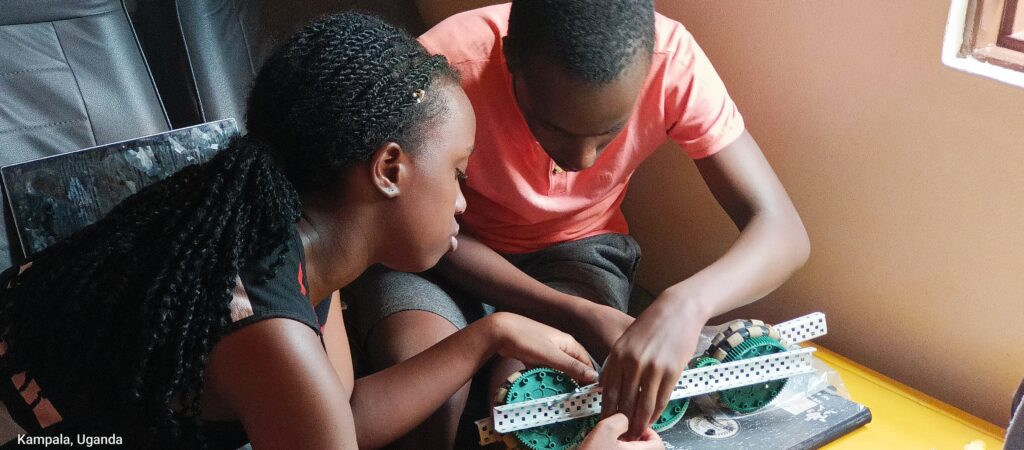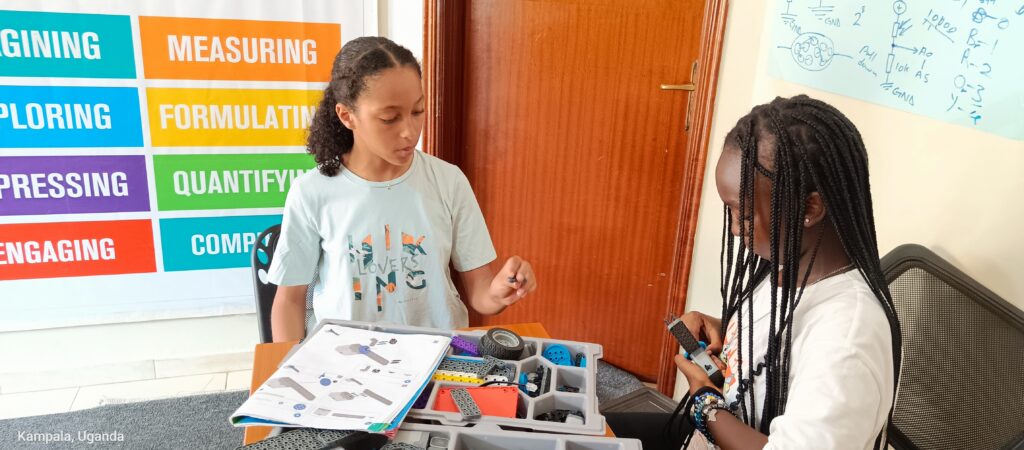In the suburbs of Ntinda-Kampala, a young girl Queen Ankunda Kajwengye, and other children of different ages build robots.
How they put the robots together tells you it’s not their first trial.
Ankunda’s mother grew up in a typically gender-aligned society. Women had to do women’s work, and anything engineering or similar was for the men. She vowed to change that narrative for her children.
“Growing up our parents decided which course of life you took, I succeeded but now the times have changed, and you can’t determine what a child will do,” Shiela Ankunda Kajwengye explains.
So, when the now 17-year-old Ankunda was 8 and had shown interest in science and technology fields, she looked for opportunities to enroll her.
She chanced upon Young Engineers, a Science Technology, Engineering and Mathematics (STEM) program run by the African School of Innovations Science and Technology (ASIST) Ltd.
“From a very early age, Ankunda showed interest in sciences, she was more into building stuff than any other thing, so when I learned about young engineers I enrolled her immediately.” Kajwengye explains.
Ankunda wants to grow up to be a doctor but not just any doctor, one that uses technology to aid in surgery. She strongly believes that AI is the future.
“It frustrates me that many Ugandans have to seek treatment from Turkey or India. I want to reduce that and I believe knowing robotics and Artificial intelligence as a whole will help me achieve my goal,” Ankunda says.
She is part of a team of eight that will represent Uganda in The Vex Robotics World Championship, an annual STEM-based competition.
In the last two years, Uganda has participated with more girls on the team in comparison to the boys in the event organized by Robotics Education & Competition Foundation (RECF), a US-based non-profit.

In Uganda and the world over, girls’ participation in STEM (Science, Technology, Engineering, and Mathematics) is much lower than that of boys.
Uganda’s National Planning Authority launched the Uganda Vision 2040 in 2013, which emphasizes gender equality and stresses the importance of mainstreaming gender in STEM fields. Despite these efforts, women and girls continue to be significantly underrepresented in STEM.
According to UBOS (2017), women occupied only 33.8% of ICT-related jobs compared to 63.2% males. In Engineering, males occupied 81.4 of the jobs while women occupied 18.6%. Causes of this gender imbalance include lack of safe ‘spaces’ for getting hands-on skills, lack of female role models, negative perceptions, lower self-esteem, discouraging remarks from adults, and intimidation from boys who dominate the science classes; and Misconceptions that STEM is for men.
“STEM education needs to be started at a young age, where the children can experience it in different but interesting ways without any gender labels,” Allen Nanyonjo, a trainer with Young Engineers explains.
–Starting them young-
At a tender age, Ankunda was enrolled in her first after-school curriculum at Young Engineers Uganda a pioneering international STEM and robotics educational initiative.
The program is designed for children aged 4-17 and operated in Uganda by the African School of Innovations Science and Technology (ASIST) Ltd a women-led organization that focuses on interesting and educating young children in STEM.
Young Engineers is a Lego and Robotics-based curriculum with hands-on training that looks at building the children’s technical proficiency as they cultivate a deep-seated curiosity and passion for science and technology.
“As the children play with legos at an early stage, they start to develop the curiosity of how it works. By the time we introduce robotics, it’s just a swap of tools and they are not seeing it as difficult,” Nanyonjo explains.
Under Young Engineers Uganda, students are not mere recipients of knowledge but active creators of solutions, engaging in real-world problem-solving. Through innovative teaching methods and exposure to diverse challenges, these young minds are honing their skills early, participating in hackathons, and contributing to advancing STEM fields.
“The aim is to kill the bias that STEM is hard and to help children see it as easy as the art subjects,” Nanyonjo explains
“In our classes, the focus is on student engagement. Teachers only allocate five to ten minutes for instruction, allowing the rest of the time for students to interact with the teacher and engage in practical, hands-on learning rather than theory,” she adds
As a women-led organization, the ratio of girls to boys is higher.
“The majority of our participants are girls, and last year, our team’s predominantly female composition earned us recognition from Google. Out of the seven team members, specifically, five were girls.” Nanyonjo explains.

As a school-led program, young engineers are run in various schools and it is implemented differently for every school.
The program offers two models tailored to suit the needs of schools—integration into the existing curriculum or as an after-school club. Many schools opt for the former, seamlessly incorporating our classes into their timetable. For others, the after-school model is preferred, providing an accessible opportunity for children to enroll in our diverse classes, according to Maureen Karamagi the founder of Young Engineers, Uganda.
Individually we work with parents for Holiday programs that run for all age groups.
“We work with schools and parents at an individual level. For now we are in over 25 schools,and as of 2024 our enrollment is about 800,” Karamagi Explains
The program, which runs in several schools in Kampala and beyond, has impacted over 2000 children since its inception in 2016.
“Our aim is to nurture the next generation of Ugandan scientists, problem solvers, innovators, and creative thinkers using a robotics and LEGO after-school curriculum,” Nanyonjo explains.
While the Young Engineers program has made a significant impact not only in Uganda but across Africa, challenges inevitably arise along the journey.
Karamagi highlights that some parents opt to enroll their children in only a few classes, resulting in inconsistent learning experiences that disrupt the educational process.
Additionally, the reluctance of certain schools to prioritize practical studies poses another obstacle, as they tend to prioritize theoretical knowledge and high scores over hands-on learning experiences.
Recent News
© 2022 - Media Challenge Initiative | All Rights Reserved .


